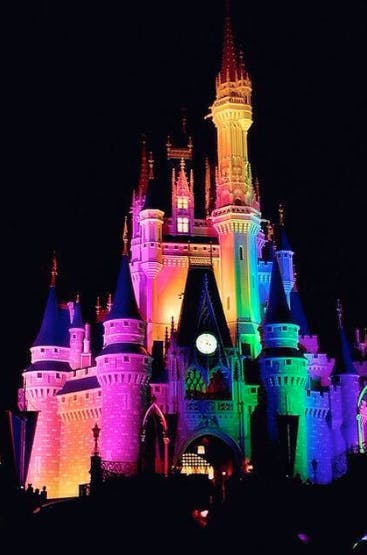When the Supreme Court ruled in favor of marriage equality, America did not burst into flames. It burst into rainbows. The White House and Niagara Falls and Mark Zuckerberg’s face turned the colors of the pride flag. So did the Cinderella Castle at Disney World, and King Glenn Beck of Rightwinglandia wasn’t pleased:
Disney is supposed to be serving all families, but have you noticed that Friday, they lit the castle up with rainbow colors? That’s quite the statement, Disney. You’ve got families there… “Mom and Dad, why is the castle in rainbows?”

Beck ended his rant by suggesting he might boycott the Disney empire, including its production of a film about Charles Darwin. (This comes, incidentally, on the heels of Beck announcing that he wants to be the next Walt Disney; so his critique is part moral crusade, part coup.) Meanwhile, Republican presidential candidate Senator Ted Cruz said the court’s decision was the result of a “propaganda effort from the mainstream media and from Hollywood.”
To which I say: Disney, give them something to really boycott. Make a romantic fairy tale starring gay characters.
Walt Disney Pictures has hardly been a pro-gay propagandist. It’s true that the Disney corporation has long supported its lesbian, gay, bisexual, and transgender employees, and hosted “Gay Days” at its theme parks. But when it comes to its most influential products, Disney merely perpetuates the heteronormative status quo.
Consider the plots of Disney’s most popular animated films. There’s the movie about the princess who seeks a prince to wed to make her life complete. And the other movie about the princess who seeks a prince to wed to make her life complete. And another one about a princess who seeks a prince to wed to make her life complete.
Over the years, feminism has found a slight toe-hold in Disney films. As my six-year-old often reports, Disney princesses have learned that “they can rescue themselves.” In Frozen, Anna saves her sister Elsa. In Brave, Merida resists a having a husband chosen for her by a Viking version of a track and field competition. Though Disney rarely sets its films in modern times, modern norms about gender equality have worked their way in. Gay norms, not so much.
Last year, a report circulated that Disney was going to produce a film called Princes, based on Jeffrey A. Miles’s children's book, The Princes and the Treasure, about two princes who fall in love. It turned out to be a false rumor, but not before going viral: It was shared on Facebook more than 60,000 times. No doubt many of these shares came from villagers from Glenbeckistan, but many others were probably elated, eager for a Disney film to finally reflect modern America. More than half of Americans today support same-sex marriage, including more than half of self-identified evangelical Millennials. The majority of Americans say they would not be upset if they had a gay son or daughter. And the majority of Americans say that, from a moral standpoint, being gay is OK. Increasingly open-minded audiences across the country have turned shows like “Modern Family” and “Orange Is the New Black” into big hits. And those shows have in turn completed the circle, transporting what was once culturally marginal into the mainstream and thus redefining what is considered mainstream in the first place. That’s what culture does. The Supreme Court has the final say on the law in America, but Hollywood has the final say on culture.
And Disney gets the opening line. As the mother of a young daughter, I have a very selfish reason for wanting a gay family in a Disney movie—so that my daughter can see her own family reflected back at her and validated within her most hallowed sphere of entertainment. In her first-grade class, my daughter was one of four kids from two-mom households. Yet that didn’t stop one boy from telling her she should have a dad. She knows better, but only because we’ve told her so. But what if that little boy grows up to be gay? The sort of self-loathing that haunts many gay teens, not to mention the increased risk of suicide, stem partly from the earliest cultural signals that gayness is not part of the ideal picture.
I don’t know exactly how Glenn Beck would respond to news of a Disney film starring gay characters, but no doubt some conservatives would fret that such a film would turn children gay. To which I have an easy retort: Snow White and The Little Mermaid and 42 trips to Disney World failed to make me straight. What a gay Disney movie would do is make gay kids and kids of gay families feel accepted for who they are, and it would teach other kids to be more accepting.
Disney has toyed with gaynimation here and there. Some argue Frozen’s hit song "Let It Go" is a “coming-out anthem” (“Conceal don’t feel, don’t let them know/ Well now they know!”); Elsa is locked away for years, as if in a closet. At one point, a troll asks whether Elsa was born with her powers or cursed, in a moment The Atlantic pointed out evokes questions of sexuality and biology. Also, Frozen has a moment where Oaken, the large friendly man who runs a trading outpost, shouts, “Hello, family!” and we see another man and four kids waving back from the sauna. The first gay couple in a Disney film?
Maybe, but this is all subtle at most, subtextual at the least. During World War II, Disney rallied to the needs of the nation and made pro-American propaganda. More than 90 percent of Disney employees were devoted to the war propaganda effort. How about devoting a measly 5 percent—say, the gay ones!—to pro-gay propaganda now. Disney is a great corporation as far as supporting their LGBT employees and celebrating gay rights. Now it's time Disney put its movies where its mouth is.
